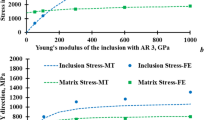Abstract
This paper demonstrates that, at extreme levels of kinematic hardening, the traditional formulation of the Bodner–Partom model can produce anomalous results. The reasons for this anomalous behaviour are explained, and a reformulated version of the model is presented. This reformulation extends the range of the model to include levels of kinematic hardening that may be problematic in the traditional formulation. The formulation of the model is adjusted so as to retain the rate dependency of the original Bodner–Partom model; and to permit the values of the material parameters used with the traditional formulation to be re-used with the extended model—with the exception only of the hardening coefficients which become dimensionless constants holding different numerical values. This revised formulation also imposes associated flow, thereby ensuring phase consistency between stress and plastic strain during non-proportional loading. In this way, the anomalies are removed, the range and stability of the model is increased, and all the advantages and important features of the Bodner–Partom model are retained.
Similar content being viewed by others
References
Bodner S.R. and Partom Y. (1975). Constitutive equations for elastic–viscoplastic strain-hardening materials. J. Appl. Mech. Trans. ASME 42(2): 385–389
Bodner, S.R.: Unified plasticity—an engineering approach. Tech. rep., Faculty of Mechanical Engineering, Technion, Israel Institute of Technology, Israel (2000)
Cecot W. (2007). Adaptive FEM analysis of selected elastic–viscoplastic problems. Comput. Methods Appl. Mech. Eng. 196(37–40): 3859–3870
Andersson H. (2003). An implicit formulation of the Bodner–Partom constitutive equations. Comput. Struct. 81(13): 1405–1414
Foringer M.A., Robertson D.D. and Mall S. (1997). A micromechanistic-based approach to fatigue life modeling of titanium–matrix composites. Compos. Part B Eng. 28(5–6): 507–521
Klosowski P., Woznica K. and Weichert D. (2000). Comparison of numerical modelling and experiments for the dynamic response of circular elasto-viscoplastic plates. Eur. J. Mech. Solids 19(2): 343–359
Liang R.Q. and Khan A.S. (1999). A critical review of experimental results and constitutive models for BCC and FCC metals over a wide range of strain rates and temperatures. Int. J. Plast. 15(9): 963–980
Shi J. and Liu C.R. (2004). The influence of material models on finite element simulation of machining. J. Manuf. Sci. Eng. Trans. ASME 126(4): 849–857
Zhuk Y.A., Senchenkov I.K., Kozlov V.I. and Tabieva G.A. (2001). Axisymmetric dynamic problem of coupled thermovisoplasticity. Int. Appl. Mech. 37(10): 1311–1317
Rowley M.A. and Thornton E.A. (1996). Constitutive modeling of the visco-plastic response of Hastelloy-X and aluminium alloy 8009. J. Eng. Mater. Technol. Trans. ASME 118(1): 19–27
Zhuk, Y.A., Guz, I.A.: Active damping of forced vibration of hinge-ended beam containing piezoactive layers with account of geometrical and physical nonlinearity. Int. Appl. Mech. (2009, in press)
Esat I.I., Bahai H. and Shati F.K. (1999). Finite element modelling of anisotropic elastic–viscoplastic behaviour of metals. Finite Elem. Anal. Des. 32(4): 279–287
Rubin M.B. and Bodner S.R. (2002). A three-dimensional nonlinear model for dissipative response of soft tissue. Int. J. Solids Struct. 39(19): 5081–5099
Mazza E., Papes O., Rubin M.B., Bodner S.R. and Binur N.S. (2005). Nonlinear elastic–viscoplastic constitutive equations for aging facial tissues. Biomech. Model. Mechanobiol. 4(2–3): 178–189
Pyrz M. and Zairi F. (2007). Identification of viscoplastic parameters of phenomenological constitutive equations for polymers by deterministic and evolutionary approach. Model. Simul. Mater. Sci. Eng. 15(2): 85–103
Chaboche J.L. (1997). Thermodynamic formulation of constitutive equations and application to the viscoplasticity and viscoelasticity of metals and polymers. Int. J. Solids Struct. 34(18): 2239–2254
Chaboche J.L. (2008). A review of some plasticity and viscoplasticity constitutive theories. Int. J. Plast. 24(10): 1642–1693
Chan, K.S., Bodner, S.R., Walker, K.P., Lindholm, U.S.: A survey of unified constitutive theories. In: Proceedings of the Second Symposium on Nonlinear Constitutive Relationships for High Temperature Applications, pp. 1–23. Cleveland, Ohio (1984)
Chan K.S., Lindholm U.S., Bodner S.R. and Walker K.P. (1989). High temperature inelastic deformation under uniaxial loading: theory and experiment. J. Eng. Mater. Technol. Trans. ASME 111: 345–353
Chan K.S., Lindholm U.S., Bodner S.R. and Nagy A. (1990). High temperature inelastic deformation of the B1900+Hf alloy under multiaxial loading: theory and experiment. J. Eng. Mater. Technol. Trans. ASME 112(1): 7–14
Chan K.S. and Lindholm U.S. (1990). Inelastic deformation under nonisothermal loading. J. Eng. Mater. Technol. Trans. ASME. 112(1): 15–25
Zhuk Y.A. and Senchenkov I.K. (2004). Resonance vibrations and dissipative heating of thin-walled laminated elements made of physically nonlinear materials. Int. Appl. Mech. 40(7): 794–802
Zhuk Y.A., Chervinko O.P. and Tabieva G.A. (2002). Planar flexural vibrations and dissipative heating of laminated rectangular plates. Int. Appl. Mech. 38(7): 837–844
Zhuk Y.A., Senchenkov I.K., Tabieva G.A. and Chervinko O.P. (2002). Axisymmetric vibrations and dissipative heating of a laminated inelastic disc. Int. Appl. Mech. 38(1): 95–102
Lemaitre J. and Chaboche J.L. (1990). Mechanics of Solid Materials. Cambridge University Press, Cambridge
Armstrong, P.J., Fredericks, C.O.: A mathematical representation of the multiaxial Bauschinger effect. Tech. rep., CEGB report No. RD/B/N 731 (1966)
Malinin N.N. and Khadjins G.M. (1972). Theory of creep with anisotropic hardening. Int. J. Mech. Sci. 14(4): 235
Sansour C. and Kollmann F.G. (1997). On theory and numerics of large viscoplastic deformation. Comput. Methods Appl. Mech. Eng. 146(3–4): 351–369
Andersson H., Persson C., Hansson T., Melin S. and Järvstråt N. (2004). Constitutive dependence in finite-element modelling of crack closure during fatigue. Fatigue Fract. Eng. Mater. Struct. 27(2): 75–87
Andersson, H.: Personal communication
Author information
Authors and Affiliations
Corresponding author
Additional information
Supported by EPSRC: EP/E30351/1.
Rights and permissions
About this article
Cite this article
Sands, C.M., Chandler, H.W., Guz, I.A. et al. Extending the Bodner–Partom model to simulate the response of materials with extreme kinematic hardening. Arch Appl Mech 80, 161–173 (2010). https://doi.org/10.1007/s00419-009-0307-0
Received:
Accepted:
Published:
Issue Date:
DOI: https://doi.org/10.1007/s00419-009-0307-0




